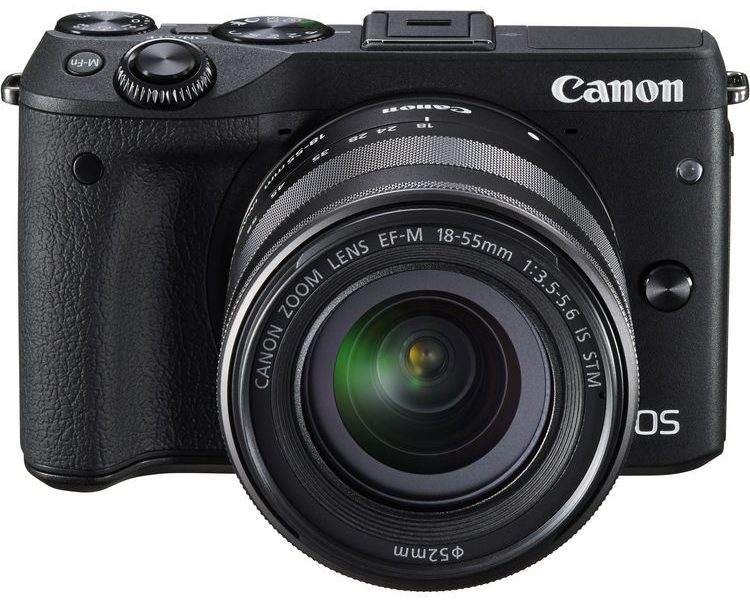4/17/19 initial draft, 9/22/19 added some pix, 12/21/19 added new pricing, 11/12/20 added some updates at conclusion.
I love Canon’s APS-C sensored M cameras and Full Frame DSLRs and have owned and used almost all current models including M3, M5, M6, M50, T3i, 60D, 70D, 7D, 7D Mark II, 5D Mark III, 5D Mark IV, 5Dsr, 6D, 6D Mark II, and the EOS R. A Full Frame Canon mirrorless camera would be a natural progression and possibly my ideal camera system. I also like trying out the latest gear. I bought the EOS R November 2018 and sold it March 2019.
Pros:
- As of Dec 2019, the price is $1499 online and as low as $1214 refurbished from Canon! This is almost 50% off from the $2300 I paid in Nov 2018!
- Potential for fast lenses. A definite plus for people who want fast lenses. For me, since I usually shoot at f/8-f/22 and with a tripod, I’d be happy with an RF 17-40 f/4, 24-70 f/4, 70-200 f/4, and a 100 macro.
- Lighter and smaller than a DSLR, but not by that much.
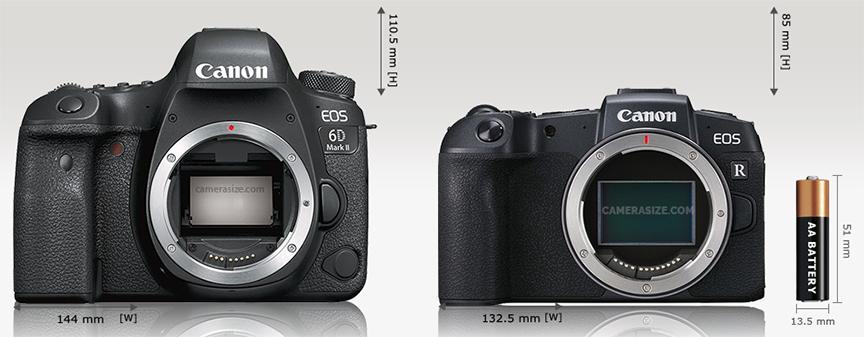
6D Mark II (765g) and EOS RP (485g) R 1.46 lbs. / 660g, RP Approx. 1.07 lbs. / 485g, 5Div 1.96lbs / 890g, 6DII 1.68lbs/765g

5D Mark IV (890g) EOS R(660g) When adding in the lenses it won’t be that big a difference where I would choose one system over another for a shoot unlike the M and EF. The durability of the body may be the trade off between smaller size and less weight, see below.
- The lens control ring is pretty cool,
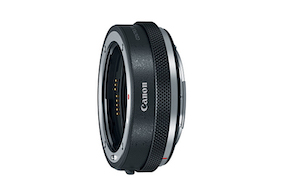 though RF lenses or the $200 Control Ring Mount Adaptor is required. Remembering the aperture control ring on my old Nikon F mount lenses this seemed like a great idea and it is, but in reality if I have a front and rear control dial on my camera body and one more on top for exposure comp then another one problem wouldn’t get used much.
though RF lenses or the $200 Control Ring Mount Adaptor is required. Remembering the aperture control ring on my old Nikon F mount lenses this seemed like a great idea and it is, but in reality if I have a front and rear control dial on my camera body and one more on top for exposure comp then another one problem wouldn’t get used much. - As with all mirrorless cameras, locking up the mirror is no longer required.
- Uses the same $80 LP-E6N battery as the DSLRs.
- Articulating screen is a feature I use all the time. Here it is in use at Zion NP and Monument Valley. The screen needs to tilt, but full articulation isn’t as important.
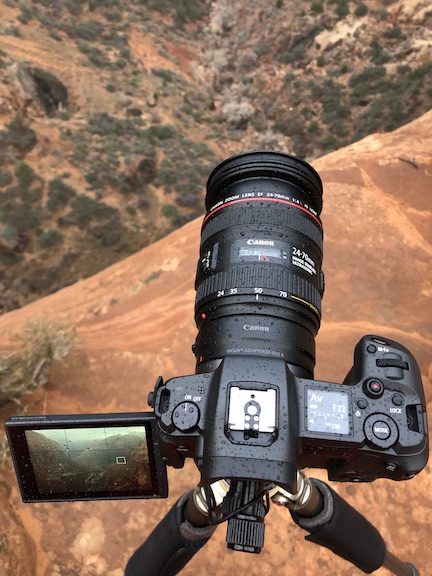
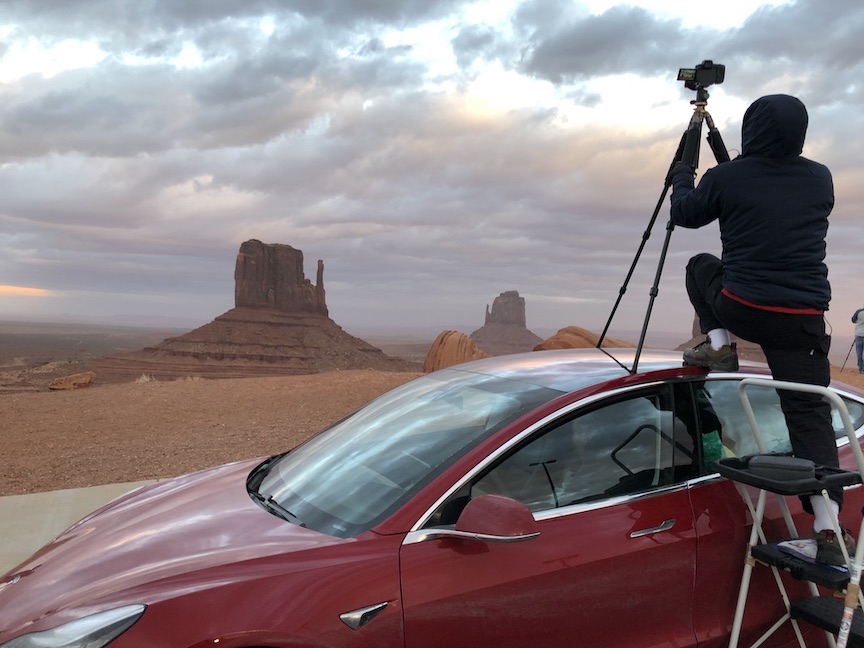
Looking at the “pros” above, no mirror to lock up doesn’t necessarily equate to no vibration. I don’t have any RF lenses or the adaptor with the control ring so didn’t get that new feature. Fast lenses don’t interest me at all. I usually use a tripod or higher ISOs if I need to freeze action and light is low. So for me, the R has no big advantage over a 5Div or 6DII.
Neutral:
- Smaller – This is a judgment call on whether this is a pro or con. I notice it when gripping the camera and shooting freehand. The grip isn’t as comfortable to hold as a 5D Mark IV since it’s smaller. This is noticeable when there is a telephoto attached and are shooting free hand.
- The common complaints from dpreview and youtube reviewers and whiners are single card slot, cropped 4k video with no DPAF, no IBIS. None of these impact me and my photography. I don’t shoot much video. When I do it’s with my M50, iPhone, and 1080/24p is my format of choice. Most of my photography is on a tripod so IBIS makes little difference to me. Two card slots? I’ve never had an SD card fail on me. Honestly, the commenters on dpreview and to some extent the reviewers just whine about missing features that are really insignificant to most photographers. They exaggerate any perceived deficiencies to justify their review I suppose.
- The viewfinder sensor to turn the LCD on and off is really annoying since I use the LCD 95% of the time. I accidentally trigger the viewfinder sensor on almost every shoot. It is configurable! 4th yellow Set-up Menu screen -> Display Settings -> Display Control -> Manual Display Control. Then select Manual display either Viewfinder or Screen. This frustrated me a while until I figured it out. There should be a better way to use both viewfinder and display for users who do.
- HDR is not great. Used it a few times, look at the results (Insert canyon view overlook Zion) I need to test this feature more, but am not impressed so far. I haven’t used it that much in my DSLRs so it’s tough to make a judgment here without more testing.
- Top deck LCD – This is a vestige leftover from the film SLR days when there was no LCD in back. This is an unnecessary feature that just consumes space and battery life. With a tiltable and flippable LCD display, why is an additional top deck LCD necessary or even desirable? It’s not. The back LCD has all the info the top deck has and with the tiltable screen no reason to have one on top.
Cons:
- Rear control dial is a d-pad up, down, left, right type and not a knurled piece of metal that the user can spin like a M3.
- Lack of affordable RF lenses – This will be addressed in the future, but in November 2019 it’s an issue. I use my EF L lenses all the time, the 24-70, 70-200, and 17-40 and there are no equivalent RF lenses until 2020-2021 at the soonest. If I have to use the adaptor, why not just use a 5D Mark IV or 6D Mark II instead of the R or RP? This is the real question for current Canon DSLR owners, why switch bodies and use an adaptor? Even if equivalent RF lenses were available, they will be more expensive than their EF equivalent. Potential or future lens releases don’t help me take better images now. Even if RF lenses were available, would the RF bodies and lens system be a better choice than the EF DSLRs and lenses? Would it be worth it to sell all my EF gear and buy a RF system? My pictures won’t be any better. Looking at the roadmap, Canon is clearly differentiating this platform from the EF bodies and lenses. The bodies are priced below and above the 6D Mark II and lower than the 5D Mark IV. The lenses are much more expensive 28-70 F/2 $3000 and not even available in an EF mount. The EF 50 1.2 is $1350 yet the RF 50 f1.2 is $2300 almost $1000 more for the same speed and focal length! Not sure what market this is aimed at but I’m not a member.
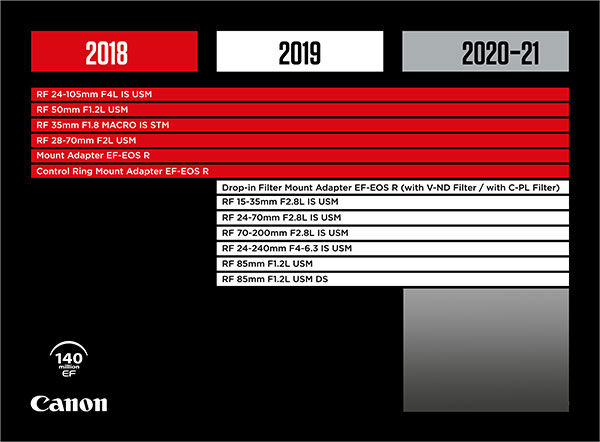
- Dynamic Range questionable. The shadows will go black and contain no detail. See EOS R Problems for an example of this. These are CR3 files that I just converted to jpegs but you see how limited the dynamic range is. I haven’t seen other users comment about this problem so it was probably my technique somehow?
- Unexplainable underexposure or overexposure. I’ve had this happen multiple times when the light is very contrasty. Settings were Av, AWB, Evaluative Metering. See this EOS R Problems page for a thorough discussion with images. I haven’t seen other users with this problem so it was probably my technique somehow.
- Banding issues: I never noticed it since I didn’t pull shadows up that much but you can read about it here. It is supposedly fixed with the latest firmware upgrade.
- Durability: So I’ve always thought durability was an issue that doesn’t impact me. We usually hear about it in terms of shutter durability good for 100,000-150,000 actuations something I never get close to. The camera body itself is another marketing claim of durability. The pro cameras are considerably heavier. Compare a Canon Rebel to a 5D or 7D series and you’ll feel the difference immediately. Anyways, my R slid off of my camera bag and onto the metal boat deck when the boat took off suddenly. The camera only dropped 7 inches and broke! I got an ERR70 and had to send in the camera to Canon for repair.
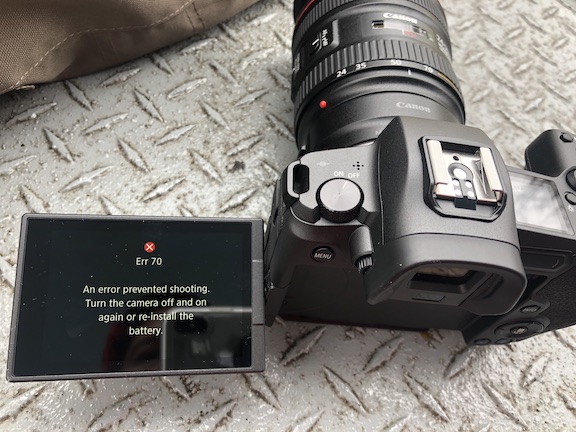
I shot the rest of the tour with my iPhone. I’ve only dropped my camera 3 times in 30+ years across two dozen bodies, but this drop disabled the camera from 7 inches! I’ve dropped my iPhone dozens of times from 3-5 feet high onto cement and it still works great. No one plans on dropping their camera, but a 7 inch drop should not totally disable a camera. - User Interface: The poor UI is the main issue I have with the R. The UI consists of the hardware and software. The placement of the buttons, dials, and switches, their design, and the software being the menu system. Overall the UI is just puzzling. It’s not more efficient than a DSLR or M camera. The design decisions don’t make much sense and take some time to get used to. I just bought a 6D Mark II and M50 and can immediately find the functions I look for and feel at home using the cameras. The R takes a while to get used to and even after 4 months I didn’t feel at home with.
- The on/off dial is just odd. Why deviate from the DSLRs or M series and come up with something new? I wear gloves since I shoot outside in below freezing weather and it is difficult to turn the R on or off with gloves on. I usually turn on in the car before going out in the cold.
- Mfn bar: The one setting I use almost every time I shoot is exposure comp, but this is not a function that is assignable to the bar. Why not? Seems like an arbitrary limitation and oddly one of the things I would actually use this bar for. I assigned ISO to it, but found myself accidentally activating it. Consequently, I just disabled it. I miss the control wheel from the DSLRs and M3 that I can spin. An additional 2 buttons or one wheel would have reduced the learning curve to 0 and been a better idea. I tried to like it but just didn’t.
- Menu vs. Q Set vs Mode vs Mfn: It’s too confusing, even the limited number of features I use the UI for can feel cumbersome and occasionally frustrating. I had to read through the manual and work through the features and still after four months don’t feel 100% at home with this camera. Any Canon DSLR or M I feel comfortable with after a few hours of learning the new features.
I didn’t like using the EOS R that much. This opinion can be quantified and qualified, but more than just the end result, a great shot, I enjoy the process of taking the picture, deciding what lens to use, composition, exposure, aperture, GND filters, etc. I have to like the camera I’m using. This is really important. It needs to be intuitive. The UI was a struggle and even after I set it up the way I wanted, an M or EF DSLR is just more intuitive and easier to use. Since the IQ is no better than a 6D Mark II or 5D Mark IV, I saw no reason to keep it. In my experience, the IQ was worse with poor shadow detail.
Myth: “It’s mirrorless so it’s the latest and greatest, and has to be better than a DSLR”
Reality: Not necessarily. Bodies may be lighter and smaller but lenses aren’t so net savings on a system isn’t really significant. The smaller grip in particular can make holding the camera with a 24-105 or larger lens feel unbalanced. Image quality is not any better. Ease and intuitiveness of operating the camera is arguably worse, much worse in my opinion. The potential is there to be marginally better than a DSLR but potential doesn’t help me take better pictures today. If image quality is no better than the DSLRs then the only selling point of R bodies and lenses is what then? I agree with the Canon executive’s dire prediction of the ILC market. Even if all the RF lenses were available that you would want and buy, would the RF bodies and lens system be a better choice than the EF DSLRs and lenses? Would you get better image quality or shoot faster or easier? There may be a shift among current DSLR owners to the R system and some new buyers moving up from a camera phone or entry level DSLR, but the overall ILC market size won’t increase due to this camera line. Canon had to develop this system due to Sony’s success.
If you are upgrading from a phone, then you would have to learn everything anyways so UI isn’t really as big an issue. Coming from a Canon DSLR and M3 background, the UI took me a while to get used to. The lighter and smaller feature is really insignificant. The future for RF lenses looks bright but I’m very happy with the 4 EF L lenses I own and shoot with. The RF lenses I would buy would be their exact equivalent. Hypothetically, suppose there were RF lenses available in the exact equivalent of what I use. To get the control ring isn’t really enough of a reason to switch over. There has to be a compelling reason in both the lens line and body line. This puts Canon in a tough spot.
If you are dead set on getting an R or RP then I would recommend the RP. The price difference of $1000, only the slight loss in resolution, absence of the multi function M-fn bar, addition of a normal mode dial, all make the RP a better value. I haven’t actually used the RP, only handled it in the store, but it appears to be a much better value.
I don’t see much reason to have both camera systems though I’d guess this is what Canon wants by differentiating both the RF and EF body and lenses. Imagine a pretty full RF line of lenses with all the current EF lenses you own or want available. Three new R bodies, 5Dsr.5, 7D Mark II.5, 5D Mark IV.5 equivalents with the 0.5 increment including Digic 8, CR3, and some other stuff. Would you sell all your Canon DSLRs and EF lenses and migrate to an RF system? If Canon updated their DSLRs with a 5Dsr Mark II, 7D Mark III, 5D Mark V I don’t see many photographers switching over. What will make Canon the most money is what they are doing now. Differentiating the EF and RF lens and body lines so photographers can justify having both systems for several years. The RP as the low end FF solution not available in the EF world. The R as an in-between 5D and 6D series. The next RF body may well be some in-between and not equivalent to a DSLR model too.
Canon full frame camera shoppers will have a tough decision, EF or RF? This question will be an issue for several years. I decided on the EF system. I sold my 7D Mark II, 5D Mark IV, 5Dsr, and R. I bought a 6D Mark II so I can use my four EF lenses. I bought a M50 too. Ideally I would have 2 cameras of the same mount and model so I don’t have to switch lenses in the field especially when it’s cold, rainy, windy, or snowing. I’ll leave the 24-70 and 70-200 mounted on each body since the 17-40 is the lens I use the least. I like the fully articulating screen of the 6D Mark II. This is one reason I decided to get a 6D Mark II and M50.
Do you really need full frame? The M series and EF-M lenses are an outstanding camera system that I highly recommend. If you enlarge prints 24×36 or larger then I would shoot full frame. If 12×18 or smaller are the prints you make then APS-C is fine. My current recommendation is to get an M6 Mark II, all the EF-M lenses excluding the 55-150, and a 6D Mark II or 5D Mark IV if you enlarge prints to 20″x30″ or larger and the M6II image quality is insufficient. The EF-M 32mm is amazingly sharp.
Conclusion:
The R system has clear potential to be a marginally better system than the current Canon EF DSLR line. With a lineup of fast and expensive lenses and new bodies, there is a bright future for the R system. Unfortunately, there are deal breaker usability and durability issues and no clear reason to switch from an EF system or to own both. Consequently, I am sticking with my Canon M3, M50, M6 Mark II and 6D Mark II. I’ll use the M’s for travel and outdoor photography. I’ll use my 6D Mark II when I might print the image 20×30 or larger and when the spot is within 30 min walk of the car. So I wouldn’t use the 6DII at a kid’s birthday party but I would at Yosemite.
I sold this camera in March 2019 and the month after the RP $1300 was released. I picked it up in Jan 2020 for $800. July 2020 the R5 $3900 and R6 $2500 were introduced. So the R really is an oddball in the line up. It appears just to be a stop gap to let users know Canon was going to get into mirrorless. Still, if the RP was introduced first, I’d still be using it two years later. I’d expect the R to be discontinued at some point, but in 2020 I would recommend the RP over the R, unless you need IBIS and have a lot more money then a R5 or R6. The RP with the 24-105 went on sale in Oct 2020 for $999!
